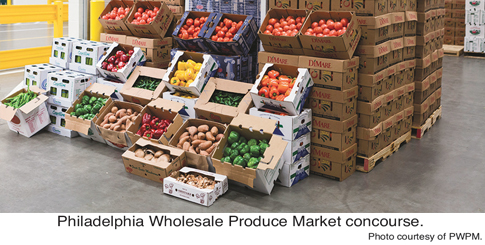In the City of Brotherly Love, the wholesale produce industry has deep historic roots but is embracing the future through diversity and expansion. Find out how those on the Philadelphia Wholesale Produce Market (PWPM) are charged up about the city’s evolution and the impact it’s causing.
“You’ll find a city alive like never before,” touts Tom Kovacevich, general manager for T.M. Kovacevich. “The restaurant scene feeds a vibrant residential and business climate, and the region is fortunate to be dissected by the Delaware River and its expanding port industry.”
The city itself, Kovacevich enthuses, “has a growing regional population of six million and business community doing over $400 billion in revenue. Other primary drivers of our local economy are the healthcare, technology, energy, finance, education, and communications industries.”
Communication plays a role in securing more international sales for the City of Brotherly Love. In this instance, the Philadelphia Regional Port Authority underwent a name change recently, when it was officially rebranded as PhilaPort. The moniker may be shorter but the port of entry’s reach is poised for considerable growth on a newly expanded 1,000-acre site.
As the most rapidly growing distribution region in the Northeast, PhilaPort serves over 41 million people within 150 miles, and is considered one of the wealthiest consumer markets in the world.
The port will expand through 2020, doubling container capacity and improving import-export efficiency— including a deep dredge project on the Delaware River to accommodate larger ships—thanks to nearly $1 billion in public and private investment.
Let’s walk the market’s docks to see how suppliers are keeping up with demand, launching new products and services, and carving niches to prosper in the Philly produce industry.
Answering the Call
Similar to many U.S. cities, the Philadelphia metropolitan area is a melting pot of ethnicities that continue to drive change at both the wholesale and retail levels.
Serving Hispanic, Korean, Chinese, Vietnamese, Japanese, Indian, and Jamaican populations, Mark Levin of M. Levin & Company, Inc. cites the diversity of the market as one of the reasons it stays so exciting. The longtime wholesaler’s product line has changed significantly over the years with plenty of once-foreign items growing into popular mainstays.
In addition to the substantial growth of the Hispanic segment, Levin cites both the Asian and Indian markets commanding a rising portion of his business.
From roots like yuca and yama to bitter melon and turmeric, “we carry things that five to ten years ago we may never have even heard of,” he shares.



